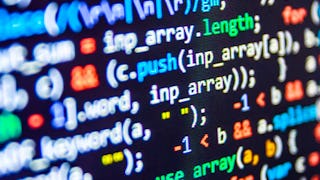Basic algorithms on tree data structures, binary search trees, self-balancing trees, graph data structures and basic traversal algorithms on graphs. This course also covers advanced topics such as kd-trees for spatial data and algorithms for spatial data.

Enjoy unlimited growth with a year of Coursera Plus for $199 (regularly $399). Save now.

Trees and Graphs: Basics
This course is part of Foundations of Data Structures and Algorithms Specialization

Instructor: Sriram Sankaranarayanan
21,185 already enrolled
Included with
(182 reviews)
Recommended experience
What you'll learn
Define basic tree data structures and identify algorithmic functions associated with them
Execute traversals and create graphs within a binary search tree structure
Describe strongly connected components in graphs
Skills you'll gain
Details to know

Add to your LinkedIn profile
16 assignments
See how employees at top companies are mastering in-demand skills

Build your subject-matter expertise
- Learn new concepts from industry experts
- Gain a foundational understanding of a subject or tool
- Develop job-relevant skills with hands-on projects
- Earn a shareable career certificate

There are 4 modules in this course
In this module, you will learn about binary search trees and basic algorithms on binary search trees. We will also become familiar with the problem of balancing in binary search trees and study some solutions for balanced binary search trees such as Red-Black Trees.
What's included
5 videos11 readings5 assignments1 programming assignment1 discussion prompt
In this module, you will learn about graphs and various basic algorithms on graphs such as depth first/breadth first traversals, finding strongly connected components, and topological sorting.
What's included
7 videos6 readings4 assignments1 programming assignment
Union Find Data-structure with rank compression. Spanning trees and properties of spanning trees. Prim’s algorithm for finding minimal spanning trees. Kruskal’s algorithm for finding minimal spanning trees.
What's included
5 videos5 readings4 assignments1 programming assignment
In this module, you will learn about: Shortest Path Problem: Basics. Bellman-Ford Algorithm for single source shortest path. Dijkstra’s algorithm. Algorithms for all-pairs shortest path problem (Floyd-Warshall Algorithm)
What's included
6 videos6 readings3 assignments1 programming assignment
Earn a career certificate
Add this credential to your LinkedIn profile, resume, or CV. Share it on social media and in your performance review.
Build toward a degree
This course is part of the following degree program(s) offered by University of Colorado Boulder. If you are admitted and enroll, your completed coursework may count toward your degree learning and your progress can transfer with you.¹
Instructor

Offered by
Explore more from Algorithms
 Status: Free Trial
Status: Free TrialUniversity of Colorado Boulder

Birla Institute of Technology & Science, Pilani
 Status: Free Trial
Status: Free TrialUniversity of Colorado Boulder
 Status: Free Trial
Status: Free TrialUniversity of Colorado Boulder
Why people choose Coursera for their career




Learner reviews
182 reviews
- 5 stars
75.82%
- 4 stars
17.03%
- 3 stars
4.39%
- 2 stars
1.09%
- 1 star
1.64%
Showing 3 of 182
Reviewed on Mar 29, 2022
I have grade 100%
Reviewed on Aug 28, 2021
Great lecturer and course materials. Assignments were fun also
Reviewed on Aug 20, 2024
The CLRS version for University of Colorado students to access online has some Chapter number changes leading to confusion about what chapter to read in weeks 3 and 4 of this course.

Open new doors with Coursera Plus
Unlimited access to 10,000+ world-class courses, hands-on projects, and job-ready certificate programs - all included in your subscription
Advance your career with an online degree
Earn a degree from world-class universities - 100% online
Join over 3,400 global companies that choose Coursera for Business
Upskill your employees to excel in the digital economy
Frequently asked questions
To access the course materials, assignments and to earn a Certificate, you will need to purchase the Certificate experience when you enroll in a course. You can try a Free Trial instead, or apply for Financial Aid. The course may offer 'Full Course, No Certificate' instead. This option lets you see all course materials, submit required assessments, and get a final grade. This also means that you will not be able to purchase a Certificate experience.
When you enroll in the course, you get access to all of the courses in the Specialization, and you earn a certificate when you complete the work. Your electronic Certificate will be added to your Accomplishments page - from there, you can print your Certificate or add it to your LinkedIn profile.
Yes. In select learning programs, you can apply for financial aid or a scholarship if you can’t afford the enrollment fee. If fin aid or scholarship is available for your learning program selection, you’ll find a link to apply on the description page.
More questions
Financial aid available,

